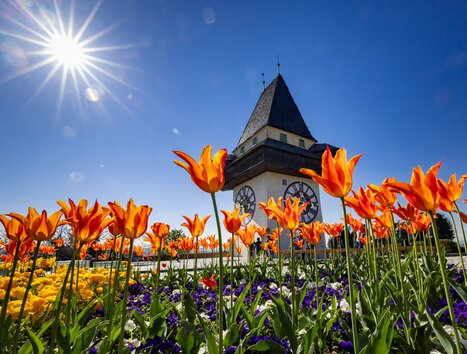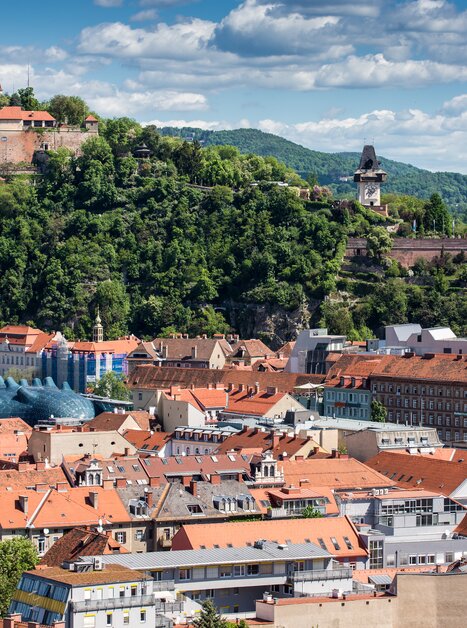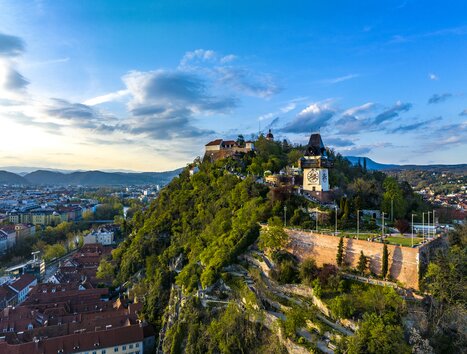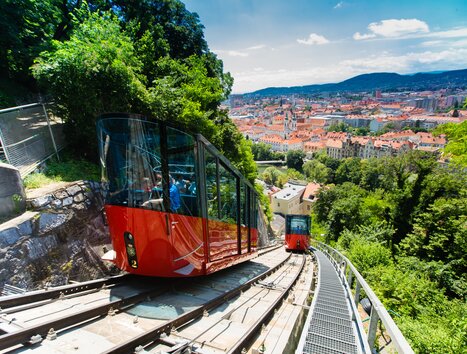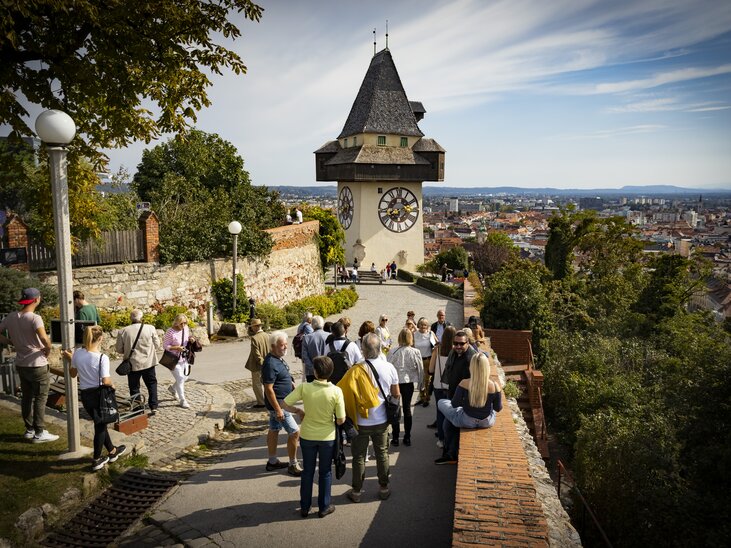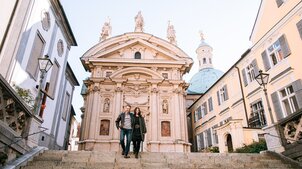Sights around the Schlossberg
Above the roofs of the city
High above the rooftops of Graz's old town is the Schlossberg - the city's green landmark and a place full of history. What once served as a mighty fortress is now a popular excursion destination that combines nature and culture in a unique way. Whether on foot, with the Schlossberg Funicular or the glass lift - the journey up is always worthwhile. Once at the top, impressive buildings such as the Clock Tower, mysterious paths and enchanted gardens await you. The Schlossberg is not only a place to marvel at, but also a living chapter in the history of Graz - and therefore the perfect starting point for a voyage of discovery through its numerous sights.
Places of interest on the Schlossberg
Once you’re on top of the Schlossberg there’s a lot to discover and a fabulous view to enjoy: from here you can see the red-tile roofscape, the hills and the mountains in the distance.
- BELL TOWER: Our first stop on the Schlossberg is the bell tower, built in 1588, which houses Graz’s most famous bell, the “Liesl”. It is unclear whether the name originates from an earlier chapel dedicated to St. Elisabeth or from the word “Verlies”, meaning dungeon (the fortress’s cruellest prison was in the cellar vault). The bell weighs nearly 5 tonnes: it took two blacksmiths working full tilt to construct the special ringing mechanism that allowed it to sound.
- KASEMATTEN STAGE: Do you have any idea what a ‘casemate’ was? Casemates were stores that were also used as sleeping quarters for prisoners. Today the Kasematten stage is the atmospheric backdrop for dazzling operas and concerts. From here it is not far to the plateau at the top and the Gothic fortress gate.
- THE GOTHIC GATE: Rediscovered in 1982, the fortress gate led from the “outer ward” to the interior of the Medieval castle and was known as the “back gate”. In the Middle Ages there was a crenellated gate tower with two archways, the outer of which is still well preserved today. In 1894 the plateau was made into a panoramic terrace. The Gothic gate was excavated between 1998 and 2001 and made accessible to the public.
- HACKHER LION: The Hackher Lion is a monument to the last military defender of the Graz fortress, Major Franz Xaver Freiherr von Hackher, who in 1809 together “with a handful of soldiers” withstood months of siege laid by the superior forces of the French. Since there was no portrait of Major Hackher a statue of a lion was erected in his honour instead. In the middle of the plateau area is the cistern. This huge cistern was built in the 16th century and has a capacity of 900,000 litres.
- GRAZ MUSEUM SCHLOSSBERG: The new Graz Museum Schlossberg opens the door on the history of the city hill in Graz. Open all year round and partly an open-air museum, it is the first point of contact for all visitors to the Schlossberg. Graz Museum Schlossberg provides visitors with information and orientation with regard to history and topography. This new, family-friendly museum presents the history of the Schlossberg and its significance for Graz in a contemporary way.
- CANNON HALL: The cannon hall in Graz Museum Schlossberg houses four cannons, which remind us of the old cannon bastion’s function as the main Graz fire station.
- CHINESE PAVILION: The Chinese Pavilion was built in 1890 and replaced an older Romanesque vine-covered terrace. The stone bench with weathered inscriptions and Gothic tracery on the rear side is known as the “Bishop’s seat” since, according to legend, it was here in 1796 that, released after enduring 40 years’ prisonment in the dungeons of the Schlossberg, the Bishop Count Nádasdy died.
- THE TURKISH WELL: From 1554 to 1558 this “deep well” was dug 94 metres down to the groundwater of the Mur in order to be able to provide the fortress with enough water during prolonged sieges. It acquired its current name only in the 19th century, because there were supposedly Turkish prisoners involved in digging it.
- STARCKE-HAUS: In 1575 a powder tower was built at the foot of the stable bastion which was then destroyed by the French in 1809. A winegrower’s house was built on its ruins and grapes planted on the terraces below. It was named after court actor Gustav Starcke, who lived in the house. Today it houses a restaurant with terraces providing a wonderful view over Graz.
- CLOCK TOWER: And finally you come to the clock tower, the traditional landmark of the city. And, although the clockwork in the 28-metre high tower has struck the hour precisely since 1712, it is still possible to lose track of time beneath this romantic symbol of Graz with its wonderful view over the city. The originally Medieval defence tower acquired its current structure in around 1560, as did the distinctive wooden walkway for the fire brigade. Three bells strike in the clock tower and three crests adorn its walls.
- HERBERSTEINGARTEN: In 1930 access was opened up to the Herbersteingarten from the “Kriegssteig”, so that the “hanging gardens of Graz” could be visited by the public. Mediterranean plants (such as fig trees, lemon trees, ginko trees and wisteria) make the terrace one of the finest examples of garden architecture from the interwar years.
- THE SYSTEM OF TUNNELS IN THE MOUNTAIN: During the Second World War, an extensive system of tunnels was built inside the mountain, which served as air raid shelters for up to 40,000 people. Some of these tunnels are still in use today; for example as a footpath through the mountain from Schlossbergplatz to Karmeliterplatz, or as access to the glass lift in the mountain and to Dom im Berg, an underground event hall. The Graz Fairytale Express in the Schlossberg also uses part of the old system of tunnels..
- SLIDE GRAZ & THE FLIGHT GRAZ 4D MOTION RIDE: Slide Graz in the Schlossberg is the tallest underground slide in the world at 64 metres. Whizzing down spiralling bends on 175 metres’ of track in about 40 seconds, this is a very special experience for all ages. The Flight Graz 4D Motion Ride takes visitors to more than 25 attractions in the city on an exciting drone flight from the perspective of a fly. You can experience Graz like never before thanks to full motion chairs and effects such as wind, fog, soap bubbles and water.
There are four ways to get to the top of the 473-metre high Schlossberg:
- By foot via the 260 steps of the Felsensteig from Schlossbergplatz. The steps were carved into the cliff by prisoners of war during the First World War.
- Alternatively, you can find paths leading to the Schlossberg from Karmeliterplatz or Wickenburggasse.
- By taking the Schlossberg Funicular: The Schlossbergbahn (funicular railway) can be reached from the Hauptplatz by following Sackstraße past Schlossbergplatz as far as Kaiser-Franz-Josef-Kai. It ascends from the lower station at an incline of 61 % – as it has done for the last 100 years. (Graz Linien public transport
tickets are valid.). The ride takes less than 2 minutes. - By using the Schlossberg Lift, you can reach the Schlossberg in about 1 minute - the entrance of the lift is located directly at Schlossbergplatz. It is an unusual, fast and yet comfortable way to achieve the ascent of Schlossberg hill. The altogether aesthetically appealing design of this lift, set in the very core of the hill, is also particularly practical if you’re in a hurry or not inclined or able to walk. During the ride, the lift’s glass cabins offer a clear view of the illuminated rocklined elevator shaft – a mountain view from within.
Inside the Schlossberg in Graz is an extensive tunnel system that originally served as an air raid shelter and is now used for a variety of purposes. Attractions include the Graz fairy tale train, an imaginative ride through lovingly designed scenes with figures, light and sound effects. The Schlossberg slide, at 64 metres the highest indoor slide in the world, offers a fast-paced experience through the mountain. In ‘The Flight Graz 4D’ adventure cinema, visitors are taken on an exciting drone flight to more than 25 attractions in the city from the perspective of a fly. Moving ‘full motion’ chairs and effects such as wind, fog, soap bubbles and water allow you to experience Graz like never before.
Yes, there are several restaurants and cafés on the Schlossberg with beautiful views, including the Schlossberg Restaurant, the aiola upstairs and the Starcke Haus. They offer regional cuisine in a special ambience with a view over Graz.
- The Skywalk on the roof terrace of Kastner & Öhler (Sackstraße 7 - 13) offers a breathtaking view of the red roofscape and the Graz Clock Tower.
- There is also a wonderful view of the Schlossberg from the Graz Kunsthaus. From the east-facing Nozzle, the view falls directly onto the Graz Clock Tower - a great photo motif!
